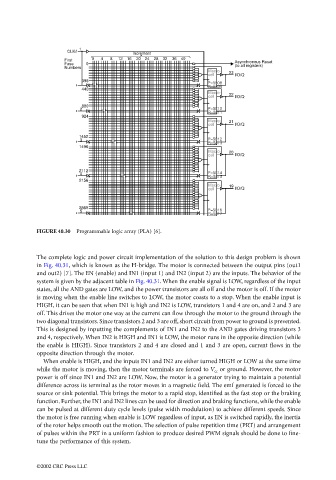Page 1108 - The Mechatronics Handbook
P. 1108
1
CLK/I
Increment
First 0 4 8 12 16 20 24 28 32 36 40 Asynchronous Reset
Fuse 0 (to all registers)
Numbers
Macro- 23
cell I/O/Q
396
P=5808
R=5809
440
Macro- 22
cell I/O/Q
880
2 P=5810
R=5811
924
Macro- 21
cell I/O/Q
1452
3 P=5812
R=5813
1496
Macro- 20
cell I/O/Q
2112
4 P=5814
R=5815
2156
Macro- 19
cell I/O/Q
2860
5 P=5816
R=5817
FIGURE 40.30 Programmable logic array (PLA) [6].
The complete logic and power circuit implementation of the solution to this design problem is shown
in Fig. 40.31, which is known as the H-bridge. The motor is connected between the output pins (out1
and out2) [7]. The EN (enable) and IN1 (input 1) and IN2 (input 2) are the inputs. The behavior of the
system is given by the adjacent table in Fig. 40.31. When the enable signal is LOW, regardless of the input
states, all the AND gates are LOW, and the power transistors are all off and the motor is off. If the motor
is moving when the enable line switches to LOW, the motor coasts to a stop. When the enable input is
HIGH, it can be seen that when IN1 is high and IN2 is LOW, transistors 1 and 4 are on, and 2 and 3 are
off. This drives the motor one way as the current can flow through the motor to the ground through the
two diagonal transistors. Since transistors 2 and 3 are off, short circuit from power to ground is prevented.
This is designed by inputting the complements of IN1 and IN2 to the AND gates driving transistors 3
and 4, respectively. When IN2 is HIGH and IN1 is LOW, the motor runs in the opposite direction (while
the enable is HIGH). Since transistors 2 and 4 are closed and 1 and 3 are open, current flows in the
opposite direction through the motor.
When enable is HIGH, and the inputs IN1 and IN2 are either turned HIGH or LOW at the same time
while the motor is moving, then the motor terminals are forced to V cc or ground. However, the motor
power is off since IN1 and IN2 are LOW. Now, the motor is a generator trying to maintain a potential
difference across its terminal as the rotor moves in a magnetic field. The emf generated is forced to the
source or sink potential. This brings the motor to a rapid stop, identified as the fast stop or the braking
function. Further, the IN1 and IN2 lines can be used for direction and braking functions, while the enable
can be pulsed at different duty cycle levels (pulse width modulation) to achieve different speeds. Since
the motor is free running when enable is LOW regardless of input, as EN is switched rapidly, the inertia
of the rotor helps smooth out the motion. The selection of pulse repetition time (PRT) and arrangement
of pulses within the PRT in a uniform fashion to produce desired PWM signals should be done to fine-
tune the performance of this system.
©2002 CRC Press LLC

